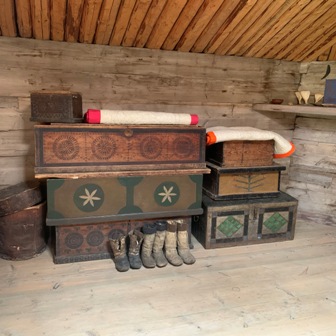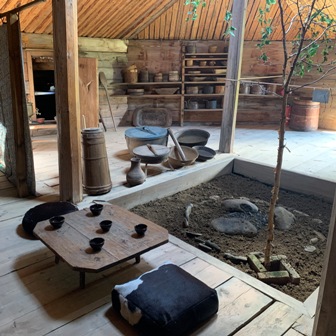Юрта шамана
|
|
 |
Юрта начала ХХ в., вывезена в
Шаманизм − одна из ранних форм религиозных верований бурят. Основывается на представлении о сверхъестественном общении служителя культа − шамана − с душами. Слово «шаман» означает «исступлённый, возбуждённый человек». Бурятские шаманы делятся на белых и черных. Белые шаманы служат 55 белым тенгеринам − божествам, живущим на юго-западном конце неба и благожелательно относящимся к людям. Чёрные шаманы служат 44 враждебным чёрным тенгеринам, живущим на северо-восточном конце неба.
По поверьям бурят, каждый предмет, каждая роща, озеро, река, гора и т. д. имеют своего хозяина. Души шаманов после смерти отправляются на небо и почитаются как божества. Все они имеют материальное воплощение − онгоны, к которым можно обратиться с молитвами, просьбами о покровительстве, излечении, невредительстве. Деятельность шамана была широка и многообразна. Они испрашивали у божеств и духов благополучие, здоровье, плодородие людям и животным, удачный промысел и хорошую погоду. При несчастье шаман призывал духов на помощь. Охраняя соплеменников при жизни, после их смерти он провожал их души в загробный мир. Его делом было распознавать причины болезней и излечивать больных, узнавать будущее, заглядывать в прошлое. В компетенцию шамана входило всё, что требовало вмешательства сверхъестественных сил.
THE SHAMAN`S YURT
The yurt of the early twentieth century relocated in 1980 from the Alaguyevsk ulus (nomad camp) of the Olkhon district in the Irkutsk region. It was renovated in 1994.
The yurt presents the exhibition "The Old Faith of the Buryat People". The Western Buryats, who lived close to Lake Baikal, to a greater extent than the Eastern Buryat kept one of the earliest forms of religious beliefs - shamanism. Shamanism is based on the idea of the supernatural communication of the cult minister - the shaman (in a state of trance, or "kamlaniye") with spirits of the upper and lower worlds.
The word "shaman", derived from the Evenk language, means "a frenzied, possessed person". Buryat shamans were divided into white and black kinds. White shamans served 55 white tengerins ("tengris")- deities that live at the Southwestern end of the sky and were benevolent towards people. The black shamans served the 44 hostile black tengerins living at the Northeast end of the sky.
According to Buryats’ beliefs, every mountain, river, lake, grove, and item has its master spirit ("ezhin"). Shamans interact with deities and spirits in many different ways. They asked spirits for well-being, health, fertility for people and animals, successful fishing and good weather. The shaman called on the spirits to help if an accident happened. The task of the shaman was to recognize the causes of diseases and heal the sick, to learn the future, to look into the past. He was responsible for everything that required the intervention of supernatural forces.
In addition, shamans made "ongons" - sacred dolls from various materials with spirits in them, to which one can turn with prayer. The Buryats had a lot of ongons, they were present in every yurt and were usually stored in special boxes, bags or birch bark bags. When it was necessary to ask the deity for any kind of favour, the Buryat took out the ongon, sprinkled “tarasun” (t/n milk alcohol) on it, " fed " Salamat” (t/n traditional dish), sour cream and said a prayer to it.
A shaman could have a family, a household, although many were unable to manage the household due to a lack of time. The structure of the shaman's yurt and its interior were traditional, except for the presence of shamanic paraphernalia.
A cut birch tree is installed in the centre of the yurt which is necessary for the rite of initiation into shamans. Its end was set in the ground and its top reached the smoke opening. The birch tree symbolized the stairway to the upper world.
The ongons " a master of fire" and "a mistress of fire" are placed on a pillar near the fireplace, several different ongons are sitting on the shelf "danhae". Next to it, there is a box for ongons, a mirror "toli", a ram's spatula for divination, pendants for a shaman's costume (a knife, a tambourine) and sacrificial troughs.
巫师蒙古包
二十世纪初的蒙古包,1980年从伊尔库茨克州奥利洪区的阿拉古叶夫斯基镇搬过来的。蒙古包于 1994年完成修复。
蒙古包里展出“布里亚特人的古老信仰”。住在贝加尔湖的西部布里亚特人信萨满教。
萨满教是与自然的变化相关的一种古老形式的宗教。每种天气和其他现象与神都有关。与鬼神沟通是通过靠近神的人“巫师”进行的。“巫师”这个词的意思是“兴奋的人。”教徒使自己进入恍惚状态,在这个状态可以跟精神进行交流与沟通。萨满祭司也分为召唤善良精神的“白色”巫师和召唤邪恶的“黑色”巫师。白巫师为55位白色 “坚格林”服务,这是住在天空西南部神灵。黑人萨满为住在天空东北部的44个“坚格林”服务。
根据布里亚特人的信念,每个山脉,河流,湖泊,树林,每个物体都有自己的灵魂。巫师曾被认为有控制天气、预言、解梦、占星以及旅行到天堂或者地狱的能力. 巫师有能力进入“人神”状态的人,有着预言、治疗,与属灵世界沟通,以及旅行到属灵世界的能力。
巫师还制作了各种护符,是一种特殊的用品,依凭它的力量来保护人的身体性命。布里亚特人有很多种护符,它们把种护符放在每个蒙古包中,放到在特殊的盒子里,袋子或白桦树皮包里。当要求助于神灵时,布里亚特人抽出护符,向护符喷上布里亚特人的一种白酒,供奉酸奶油,然后开始祈祷。
巫师可以有自己的家庭,饲养牲畜, 有的巫师由于时间不足而无法饲养牲畜和管理家务。萨满的蒙古包的布置和普通的蒙古包一样,装饰是传统的,住宅里还有萨满用具。
中庭部分利用一个环形的金属圈连接套牢笔直的白桦木杆,杆的另一头就用绳子绑紧格栅的V型口位置。桦树象征着通往上层世界的阶梯。
炉膛附近的柱子上放置着各种护符,旁边有用于存放护符的盒子,一面镜子,一副用于算命的小羊脚,巫师的服饰(刀子,手鼓),牺牲品槽。
Заявка успешно отправлена!
Укажите свои данные
мы ответим на ваш вопрос









